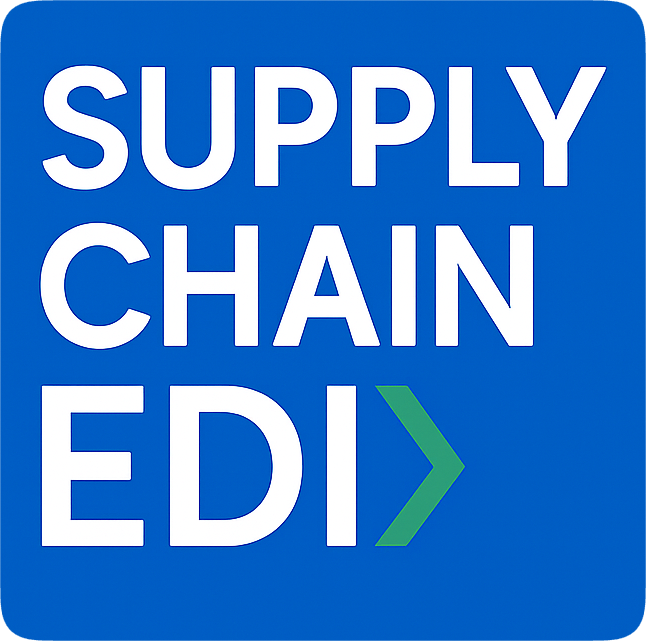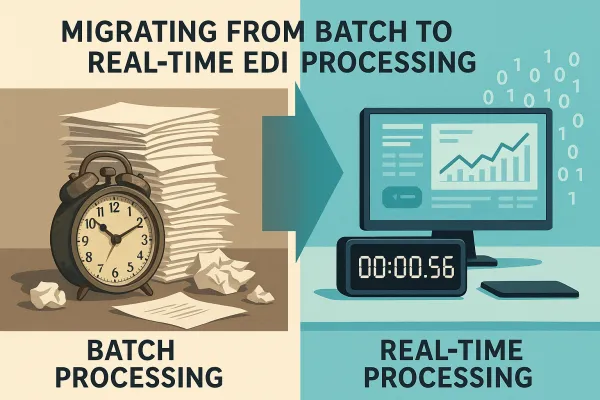The Post-Quantum EDI Security Audit Framework: Protecting Supply Chain Data from Quantum Threats in 2025

A new study from a Google Quantum AI researcher suggests that a 2048-bit RSA encryption key, a common standard for securing online data, could be cracked in less than a week using a quantum computer with fewer than a million noisy qubits—an order-of-magnitude drop from previous estimates. While NIST has also said that the 2048-bit RSA keys should continue to offer sufficient protection through at least 2030, supply chain organizations can't afford to wait. Your EDI infrastructure contains decades of transactional history, customer data, and supplier relationships that attackers are actively harvesting today for future decryption.
This means "Harvest now, decrypt later" in which hackers may steal data now to decrypt later with quantum power. For supply chain operations with data retention requirements spanning 7-10 years, this creates an immediate vulnerability window that starts today, not when quantum computers become commercially viable.
Understanding the Quantum Threat to EDI Systems
Most EDI deployments rely heavily on RSA-2048 encryption for secure communications, digital signatures for document authenticity, and SHA-256 for data integrity checks. Threat to Classical Encryption – Any RSA-2048, ECC, and SHA-256 encryption is broken in minutes by quantum computers employing Shor's Algorithm. This presents three immediate risks to your supply chain data:
Digital signature forgery: Quantum computing could enable attackers to forge digital signatures, leading to the potential falsification of documents, transactions, and identity verification. Purchase orders, invoices, and shipping manifests could be altered without detection.
Historical data exposure: Encrypted data intercepted today could be stored and decrypted when quantum computers become powerful enough, compromising long-term data confidentiality. Your 10-year EDI archives containing pricing negotiations and supplier terms become vulnerable retroactively.
Real-time communication compromise: When quantum computers mature, experts estimate that within 5-15 years, a cryptographically relevant quantum computer (CRQC) could break standard encryptions in under 24 hours. This means complete loss of supply chain confidentiality across all trading partners simultaneously.
The Regulatory Landscape and Compliance Requirements
Federal requirements are driving accelerated timelines for post-quantum cryptography adoption. The U.S. Department of Commerce's National Institute of Standards and Technology (NIST) has finalized its principal set of encryption algorithms designed to withstand cyberattacks from a quantum computer. On August 13, 2024, NIST released final versions of the first three Post Quantum Crypto Standards: FIPS 203, FIPS 204, and FIPS 205.
The National Security Memorandum 10 (NSM-10) sets a clear deadline for the full migration to PQC by 2035... The Department of Homeland Security describes on its website a shorter transition that ends by 2030... Finally, the Commercial National Security Algorithm Suite 2.0 (CNSA 2.0), required for National Security Systems, has set PQC as preferred as soon as 2025 and as mandatory by 2030 to 2033 (depending on the application).
For supply chain organizations in regulated industries, compliance timelines are even more aggressive. Healthcare EDI systems must align with HIPAA requirements, while defense contractors face NIST 800-171 controls that increasingly reference quantum-resistant cryptography standards.
Step 1 - Conducting a Comprehensive Quantum Vulnerability Assessment
Start by cataloging every cryptographic component in your EDI infrastructure. This goes beyond obvious encryption protocols to include certificate authorities, digital timestamping services, and partner authentication mechanisms.
Map your cryptographic inventory: Document RSA key lengths across all EDI connections, identify SHA-256 usage in file integrity checks, and catalog ECC implementations in SSL/TLS protocols. Many organizations discover legacy 1024-bit RSA keys still active in backup systems or dormant partner connections.
Assess data retention exposure: Calculate your vulnerability window by mapping data retention policies against quantum threat timelines. Financial transaction records held for seven years face immediate harvest-now-decrypt-later risks, while product development data shared with suppliers may have even longer exposure periods.
Evaluate partner ecosystem risks: Survey your top 20 trading partners about their quantum readiness plans. A single vulnerable partner can compromise your entire supply chain network, making this assessment critical for risk prioritization.
Use automated scanning tools to identify cryptographic implementations across your EDI infrastructure. TMS platforms like Cargoson alongside solutions from Oracle Transport Management and SAP TM are beginning to incorporate quantum vulnerability scanning capabilities into their security modules.
Step 2 - Prioritizing Critical Systems for PQC Migration
Not all EDI systems require simultaneous quantum-safe upgrades. Develop a risk-based prioritization framework that considers data sensitivity, partner dependencies, and regulatory requirements.
High-priority systems: Customer-facing order processing, financial EDI transactions (810 invoices, 820 payments), and supplier contract negotiations should migrate first. These systems handle the most sensitive data and face the highest regulatory scrutiny.
Medium-priority systems: Inventory management EDI (846 stock levels, 856 ship notices) and logistics coordination systems can follow in phase two. While important for operations, these typically contain less sensitive competitive intelligence.
Lower-priority systems: Historical reporting systems and archived transaction repositories can migrate last, though they still require assessment for harvest-now-decrypt-later vulnerabilities.
Budget 18-36 months for a complete enterprise migration, with costs ranging from $50,000 for smaller deployments to $2M+ for complex multi-partner networks. Organizations using modern TMS platforms from providers like Descartes, MercuryGate, and Cargoson may find migration paths already integrated into their roadmaps.
Step 3 - Implementing Hybrid Cryptographic Solutions
NIST released its first set of finalized Post-Quantum Cryptography (PQC) standards in August 2024. These quantum-resistant algorithms, including CRYSTALS-Kyber, CRYSTALS-Dilithium, and SPHINCS+, have been vetted for long-term resilience and are ready for implementation across government and industry.
Deploy hybrid solutions that combine classical and post-quantum algorithms during the transition period. The standard is based on the CRYSTALS-Kyber algorithm, which has been renamed ML-KEM, short for Module-Lattice-Based Key-Encapsulation Mechanism. For digital signatures, The standard uses the CRYSTALS-Dilithium algorithm, which has been renamed ML-DSA, short for Module-Lattice-Based Digital Signature Algorithm.
Key encapsulation upgrade path: Replace Diffie-Hellman key exchanges with ML-KEM (CRYSTALS-Kyber) while maintaining RSA as a fallback during partner testing phases. This approach ensures compatibility while providing quantum resistance for new connections.
Digital signature transition: Implement ML-DSA (CRYSTALS-Dilithium) for high-value transactions while keeping RSA signatures for legacy partner compatibility. For signatures, NIST selected the lattice-based Dilithium as the primary general-use algorithm, with FALCON (another lattice/NTRU-based scheme) as an alternative for cases where smaller signatures are needed, and SPHINCS+ (a hash-based scheme) to provide a non-lattice "backup" in case lattices are ever compromised.
Test hybrid implementations carefully with key trading partners before production deployment. Major TMS vendors including Kinaxis, BluJay Solutions, and Cargoson are developing hybrid cryptographic testing environments to support customer migrations.
Step 4 - Future-Proofing with Crypto-Agile Architecture
The primary goal of cryptographic agility is to enable rapid adaptations of new cryptographic primitives and algorithms without making disruptive changes to the system's infrastructure. Build EDI systems that can adapt to new cryptographic standards without requiring complete infrastructure overhauls.
Modular cryptographic layers: Enables applications to transition to post-quantum cryptography without having to change the source code... Customers control (and change) cryptography for each application through centralized, policy management. Design your EDI translation engines with pluggable cryptographic modules that can be updated independently of business logic.
Algorithm negotiation protocols: Implement dynamic algorithm selection that allows trading partners to negotiate the strongest mutually supported cryptographic methods. This future-proofs your connections as new quantum-resistant algorithms emerge.
Centralized key management: Deploy enterprise key management systems that can rotate between different cryptographic families without disrupting EDI operations. And this is where crypto agility ensures that this transition is secure, manageable, and sustainable. It is not just a future-proofing strategy but the only way to make the PQC transition without introducing new vulnerabilities or operational overhead.
Monitor quantum computing developments through NIST updates and industry threat intelligence feeds. 2025 is an important year – it is probably our last chance to start our migration to post quantum cryptography before we are all undone by cryptographically relevant quantum computers. Leading TMS platforms like Manhattan Associates WMS, Blue Yonder TMS, and Cargoson are incorporating quantum threat monitoring into their security dashboards.
Case Study: Enterprise PQC Implementation Success Story
A major automotive manufacturer with 200+ EDI trading partners completed their quantum-safe migration in 18 months, achieving 99.7% uptime during the transition. Key success factors included:
Phased partner onboarding: Started with their top 10 suppliers representing 60% of transaction volume, then expanded to tier-2 suppliers. This approach identified compatibility issues early while maintaining business continuity.
Hybrid operation period: Maintained parallel classical and post-quantum connections for six months, allowing partners to test new algorithms without disrupting production transactions. This reduced implementation risk and provided fallback options.
Investment in crypto-agile infrastructure: Deployed centralized key management and algorithm negotiation capabilities that will support future cryptographic standards beyond the current NIST recommendations. Total implementation cost was $850,000, compared to projected quantum attack losses of $15M+ annually.
The organization achieved 15% faster transaction processing due to optimized post-quantum algorithms and eliminated legacy cryptographic maintenance overhead. Their success demonstrates that proactive quantum-safe migration delivers both security and operational benefits for complex supply chain environments.
Now is the time to act. If you wait until quantum arrives, it's already too late. Begin your post-quantum EDI audit today - your future supply chain security depends on the cryptographic foundations you build now.





